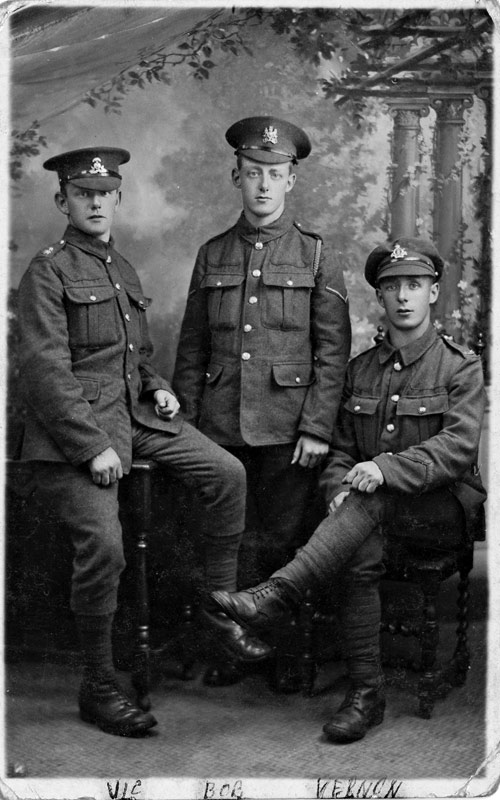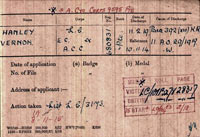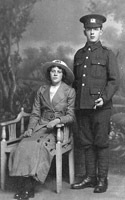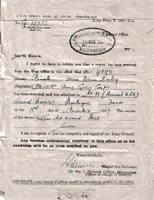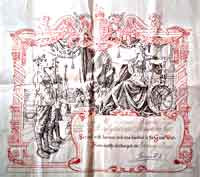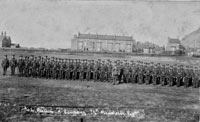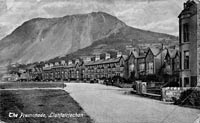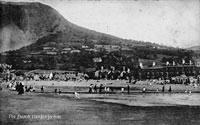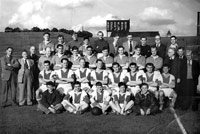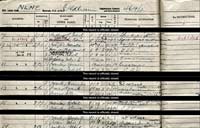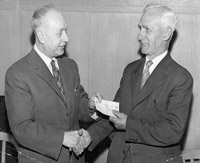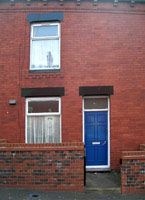
'SERVICEMEN WE KNOW'
Vernon Hanley, Vernon Hanley was born Vernon 'Wallwork' on the 14th December 1893 in Stacksteads, Bacup, Haslingden in Lancashire. His birth certificate lists his mother as Sarah Ellen Wallwork but does not list a father. This is presumably because Sarah did not marry Thomas Hanley until Sept 1894. Thomas Hanley was either not Vernon's 'biological' father or, as seems to happen with a lot of birth certificates at this time, the registrar never asked for father's name when the mother was unmarried. It is very likely that Sarah and Thomas' relationship was difficult as the Wallworks were quite a strict Methodist family and Thomas was a 2nd Generation Irish Catholic and at that time, in that part of the world, the Irish community was not well regarded. On the balance of probability it is likely that Thomas was the father but a very unpopular choice of partner with the Wallwork family. The various details of the marriage do seem to indicate a fall-out over the marriage…. thumbnail links to larger copies
Vernon lost his father, Thomas in 1903 when Thomas was only 30.
The photograph (at the top of the page) shows Vernon with his two brothers Bob and Vic. Victor served in the Lancashire Fusiliers as a Private (Number 5307). I am unsure in which regiment Bob served. (From Left to right; Victor Hanley, Robert Hanley and Vernon Hanley) Correspondence from Government in 1914 confirms that Vernon lived at 17 Davies Street. Medals in the family confirm his military details as 'Private Vernon Hanley No 680831'
~~~~~~~~~~~~~~~~~~~~~~~~~~~~~~~~~~~~~~~~~~~~~~~~~~~~~~~~~~~~~ Although my Great-Grandad would only have served with the 24th Manchesters, 'the Comrades', during training, and in France in late 1915 (until he transferred to the Army Cyclist Company), I have recorded a brief history of where they served. History of the 24th Manchester Regiment, Pioneer Battalion (Oldham Comrades). The battalion was raised in Oldham in November 1914. Competing with many other regiments, including other Manchester and Lancashire Battalions, the town struggled to meet its target of 1,150 men, which it finally did by January 1915. The Oldham battalion, showing its individuality, adopted the term 'Comrades' rather than 'Pals' They went into camp at Chadderton Hall farm off Burnley Road in Chadderton, in 36 huts, and started their training. On the 8th March 1915 the battalion left its home town and moved to Llanfairfechan, where training was continued. My Great-Grandad collected numerous postcards of the town that form part of my Great Grandma's collection. In May 1915 the 24th moved to Grantham as part of the 91st Brigade, 30th Division. In September 1915 they moved to Larkhill Camp on Salisbury Plain. In early November 1915 the 24th landed at Le Havre, and then entrained for the front, where they had their first experience in the forward lines, under the instruction of a battalion of the Leicesters, in the Albert and Arras sectors. It was here, on 2nd December that they suffered their first casualty of the war, Fred Gilbert, who was wounded whilst in a listening post. Later in December the 24th Battalion, along with the rest of the 91st Brigade, was transferred to the 7th Division. The 30th Division would also serve along this front. It's quite possible that, by December, Vernon was already in the 30th Division Cyclist Company, and would remain with this Division when the 24th Manchesters were transferrred. We know, from messages on the postcards that Vernon sent, that, in May 1916, he was with the Cyclist Corps in the 30th Division. He wrote of the problems of 'riding in the dark trying to avoid shell holes' etc., and of the prospect of a 'busy night' when there was heavy bombardment. However, judging from the postcard images and messages, he was not too far from the 24th Manchesters, and, on one card, writes of visiting his 'old Battalion' that day. Referencing the website 'LONG LONG TRAIL' we can learn that at the beginning of the war a Cyclist Company had been created for each of the new Divisions raised by Lord Kitchener (in Vernon's case, with the 24th Manchesters, the 30th). With the 7th Division, the 24th battalion moved to the village of Aumont, near Amiens, then later to Morlancourt near Albert by the beginning of February. So far, the battalion had suffered some casualties but no fatalities as yet but, on the 6th February, three officers and three other ranks were killed and several injured. Then, on the following day, another eleven men were killed and eight wounded. My Great-Grandad sent back numerous cards depicting the buildings before and after the German bombardments in Albert and Amiens ... all dated May 1916 He would continue to serve, with the Army Cyclist Corps, along the Western Front, on the Somme and at Ypres, until he was injured on the 8th November 1917.
My Grandad was sent to an American hospital in Boulogne, France and I don't know when, or even if, he was fit enough to rejoin the Cyclist Corps. Meanwhile, instead of the front line infantry unit, for which the recruits of the 24th had originally volunteered, the battalion would, on the 22nd May 1916, become one of the new Pioneer Battalions. In the battle of the Somme the 24th were engaged in converting the German trenches captured around Fricourt into strong-points and consolidating the gains of the 7th Division. Compared with other units the battalion suffered very light casualties of eight men. On the 14th July the battalion followed up the attack on Bazention le Petit, to build a strongpoint in the village, suffering 52 casualties. On the 30th August the 7th Division was to make its attack on the disputed village of Guinchy, the 24th were employed building the support trenches needed. Although the attack was not successful, the preparation work cost the battalion 38 casualties. In September the 24th moved away from the front to Steenwerck near Armentieres, where part of the battalion was attached to a tunneling company, with others involved in building projects. In November a working party of 400 Oldhamers constructed an 800 yard new trench with three strong-points in one night. The year continued in much the same way as the Germans retreated to the Hindenberg Line. In June 1917 the 7th division was moved up to the Ypres area and then on to Hazebrouck, then to Wizernes, to Ridge Camp near Ouderdoom. During the battle of Third Ypres the battalion was working in the Sanctury Wood area, preparing access, for the attacking troops, under shell fire from the German lines, and providing guides. Three Military Medals were won by them at this time. They were moved from the forward areas on the 30th October. In November 1917 the 24th Battalion had entrained for Italy, arriving at Paderno on the 19th December. In italy, the 24th battalion was used in wiring and defence building, along with morale building actions with Italian troops. They later moved to Casa di Foraro on the Asiago Plateau, where again the pioneers continued their work. The battle of Piave in October 1918, had seen the 24th employed as guides, bringing the troops up to the bridges and as pioneers preparing the ground. Assisting the Royal Engineers, they kept the bridges repaired and passable, bringing up supplies and in general support. By 31st October the Division had crossed the Piave and by the 3rd November, they had progressed 28 miles to the Tagliamento River. On the 4th of November 1918, the Oldham Comrades (24th) finished the war as the Pioneer Battalion of 7th Division, Italy near Udine. ~~~~~~~~~~~~~~~~~~~~~~~~~~~~~~~~~~~~ After the war Vernon worked as a self-employed steeplejack (A steeplejack was someone who carried out repairs, maintenance etc, on chimneys, steeples, tall buildings.) My grandma recalls that he worked on the tallest chimney in England at the time. She also recalls it was in London but not where. (Clearly something went astray in the genes as I can't go up a ladder without shaking!!) My Grandma recalls that times became tough around the early '30s and often my great-grandad wasn't getting paid for work. He took a job as a bricklayer for Bloors Builders (who are still in existence today). William Bloor was a director at Oldham Athletic and soon afterwards he offered my great grandad a job at the club.
Also, on his daughter Vera's marriage certificate in 1944, it also records his occupation as bricklayer, perhaps as it was summer, and during the war, he was working as a bricklayer as well as doing the groundsman role.
~~~~~~~~~~~~~~~~~~~~~~~~~~~ Vernon and Edith had 4 children – Edith Hanley was born in Oldham on the 16th of August 1915. Edith married James Nelson (who was born in 1913) on the 26th of January 1935 at the Grosvenor Hall Mission in Oldham. James and Edith had 3 children, James in 1936, Jeffrey in 1943 and Joyce. The family emigrated to Australia, and my Grandma was never to see her sister again. Edith died on the 13th March 2003. Doris Hanley was born on the 28th January 1920. Doris married Ronald Parkinson on the 14th September 1940 at Grosvenor Hall Mission, Oldham in Lancashire. After their marriage, with my Grandad in the army, they first lived with my Grandad's mother at 79 Rochdale Road, Oldham before moving to their first house at 44, Crompton Street, Oldham. Doris died on the 23rd May 2017 aged 97. Vera Hanley was born on the 13th July 1922 in Oldham. She married Harold Kitching on the 25th July 1944 at All Saints Church, Northmoor, Oldham just as Vera's parents had done 29 years earlier. At the time of the marriage Harold was in the army and Vera was working as a cotton winder. Vera died of cancer in August of 2013 whilst living in Poulton-le-Fylde, near Blackpool, Lancashire. Vernon Hanley was born on the 8th December 1926 in Oldham. He married Alma Taylor who was born in 1935, on the 29th November 1954. They married at Ashton Road Congregational Church, Oldham. Vernon died of a heart attack in 1992.
Source Documents: Family Bible – In possession of David Parkinson Contributed by Phil Howell |
